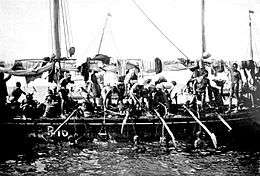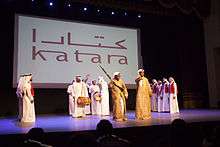Music of Qatar
The music of Qatar is based on sea folk poetry, song and dance. Traditional dances in Doha are performed on Friday afternoons; one such dance is the Ardah, a stylized martial dance performed by two rows of dancers who are accompanied by an array of percussion instruments, including al-ras (a large drum whose leather is heated by an open fire), tambourines and cymbals with small drums. Other folk instruments include the oud and rebaba, both string instruments, as well as the ney.
| Part of a series on the |
| Culture of Qatar |
|---|
 |
| History |
| People |
| Languages |
| Cuisine |
|
Festivals |
| Religion |
|
Music and performing arts |
|
Media |
| Sport |
|
Monuments
|
|
Symbols
|
Male-only folk music
Sea music

Work songs relating to the sea are the most recurrent type of folk music, particularly songs pertaining to pearl hunting.[1][2] Each song, varying in rhythm, would narrate a different activity of the pearling trip, including spreading the sails, diving, and rowing the ships. Collective singing was an integral part of each pearling trip, and each ship had a designated singer, known locally as al naham. Singing was used to encourage crew members to work harder during the pearling drip, in addition to providing entertainment while they were resting.[1]
Dance
Ardah, a folkloric dance, is still practiced in Qatar.[3] The dance is performed with two rows of men opposite of one another, each of whom may or may not be wielding a sword, and is accompanied by drums and spoken poetry.[4]
The two main types of ardah in the Persian Gulf states are land ardah (ardah barriyya) and sea ardah (ardah bahri). Qatar's ardah is a mixture of the two. In some performances, men wear land ardah attire at a beach setting and are supported by sea band drumming.[5]
Female-only folk music
Women primarily sang work songs associated with daily activities such as wheat grinding and cooking. The songs were performed collectively in small groups and varied in specificity - some pertained to general themes, whereas others were related to specific processes.[6]
Women would also sing when returning pearl ships were sighted.[1] After a sighting was made, they would gather around the seashore where they would clap and sing about the hardships of pearl diving.[6]
Dance
Public performances by women were practiced only on two annual occasions. The first was al-moradah, which involved women and girls of all social classes gathering in a secluded area where they would sing and dance in embroidered clothes. This was usually done in the weeks preceding Eid al-Fitr and Eid al-Adha.[6] It was one of the most popular musical practices among Qatari women in previous decades. Each moradah would begin with a prayer to Muhammad. After this, the women would praise tribal leaders and elders, repeating each verse twice before a new verse was introduced. It was performed with two rows of women opposite of each other with the lead singers at the far ends, thus forming a three-sided rectangle. Moradah's dance consisted of all the women in each row swaying their bodies and moving their arms up and down while their hands were interlaced.[7] For the most part, the practice was abandoned during the 1950s,[6] though it is still sometimes practiced at the end of weddings.[7] There have been efforts by Qatar's ministry of culture to reintegrate the practice in Qatari society.[6]
The second occasion of collective public singing, known as al-ashori, was performed exclusively at weddings. There were two main instruments used during a performance: al daf, a type of tambourine and al tabl, a longtidunal drum. Thematically, ashori songs are cheerful as they rejoice the marriage which is taking place.[8] The lyrics are derived from nabati verse, a type of Arabic poetry and were generally symbiotic in nature. Ashori is still practiced by some classes of Qatari society.[8]
Folk instruments

Percussion instruments are most popular in Qatari folk music. Galahs, a tall clay jar, was commonly used as a musical instrument by pearl fishermen. Tin drinking cups known as tus or tasat were also used, usually in conjunction with a tabl, a longitudinal drum beaten with a stick.[9]
Contemporary music
Local music artists are subject to many barriers in Qatar, such as lack of awareness, high prices of recording studios and a deficiency of agents.[10]
Music institutions
In August 1980, the Ministry of Information established a subsidiary organization to serve as a music academy, referring to it as "the Institute".[11] An academy building was provided to the institute by the government and it began classes on 1 October, 1980 with an initial capacity for 20 aspiring musicians.[12]
Qatar Foundation was responsible for commissioning the Qatar Music Academy in Katara Cultural Village in January 2011.[13] Although the academy's primary focal point is providing musical education for children and teenagers from 5 to 18 years old, it also provides education for individuals not falling within that age bracket through its 'music for all' program.[14]
Qatar Philharmonic Orchestra
The Qatar Philharmonic Orchestra was formed in 2007 at the behest of Qatar Foundation with an initial budget of $14 million.[15]

Recording companies
The first Qatari record label was established in January, 2015 by Dana Al Fardan as DNA Records.[16]
Arabic/gulf music
Many contemporary Qatari singers perform what is popularly known as khaliji ('gulf') music. Notable male artists in this genre include Fahad Al Kubaisi, the first artist out of the Arab states of the Persian Gulf to be nominated for a Grammy award,[17] Essa Al Kubaisi,[18] Ali Abdul Sattar,[19] and Bader Al Rayes.[20]
Metal/rock
Naser Mestarihi, a Qatari born Jordanian-Pakistani singer-songwriter and multi-instrumentalist became the first rock/metal musician to release an album out of Qatar. He was also a member of Qatar's first ever metal band Asgard Legionnaires.[21]
References
- Abu Saud, Abeer (1984). Qatari Women: Past and Present. Longman Group. p. 146. ISBN 978-0582783720.
- "Qatari folk music entertains Doha mall-goers". Qatar Tribune. Archived from the original on 25 May 2015. Retrieved 26 April 2015.
- "Arts and Culture". Embassy of Qatar in London. Retrieved 26 April 2015.
- Urkevich, Lisa (19 December 2014). "5". Music and Traditions of the Arabian Peninsula: Saudi Arabia, Kuwait, Bahrain, and Qatar (Google Play). Routledge. pp. 142–143/689. ISBN 978-0415888721.
- Urkevich, Lisa (19 December 2014). "5". Music and Traditions of the Arabian Peninsula: Saudi Arabia, Kuwait, Bahrain, and Qatar (Google Play). Routledge. p. 131/689. ISBN 978-0415888721.
- Abu Saud, p. 147
- Urkevich, Lisa (19 December 2014). "7". Music and Traditions of the Arabian Peninsula: Saudi Arabia, Kuwait, Bahrain, and Qatar (Google Play). Routledge. pp. 244–245/689. ISBN 978-0415888721.
- Abu Saud, p. 149
- "Heritage and Culture". Qatar e-Gov. Archived from the original on 4 March 2015. Retrieved 26 April 2015.
- Chantelle D'Mello (22 September 2015). "Qatari artist Dana Al Fardan, Robin Schulz to launch new collaboration". Doha News. Archived from the original on 5 July 2018. Retrieved 27 September 2015.
- "Resolution of the Council of Ministers No. 5 of 1980 on the Establishment of an Institute of Music". Qatari Legal Portal (Al Meezan). Retrieved 25 July 2018.
- Qatar: Year Book 1980–81. Doha: Press and Publications Department, Ministry of Information. 1981. p. 76.
- "Qatar Music Academy". Katara Cultural Village. Retrieved 25 July 2018.
- "Making Music Accessible For All". Qatar Foundation. 12 November 2013. Archived from the original on 26 July 2018. Retrieved 25 July 2018.
- Daniel J. Wakin (27 February 2009). "A New Orchestra, Built From Scratch". The New York Times. Retrieved 25 July 2018.
- "Dana Al Fardan launches new record label, DNA Records". qatarisbooming.com. 15 January 2015. Retrieved 27 September 2015.
- "Qatari musician Kubaisi nominated for Grammy". Gulf Times. 17 November 2017. Archived from the original on 5 July 2018. Retrieved 5 July 2018.
- Jomana Karadsheh and Victoria Brown (27 July 2017). "Qataris rally behind Emir amid Gulf crisis". CNN. Retrieved 5 July 2018.CS1 maint: uses authors parameter (link)
- "FNAC Qatar marks first anniversary". Gulf Times. 24 May 2017. Retrieved 5 July 2018.
- "Moussem de Tan-Tan: une première soirée faite de séduction musicale". Atlasinfo.fr (in French). 6 May 2017. Retrieved 5 July 2018.
- "Asgard Legionnaires". Retrieved 22 September 2016.
Further reading
- Kerbage, Toufic (1982). The Rhythms of the Pearl Diver Music in Qatar. Culture & Art Directorate Ministry of Information Doha Qatar. Bahrain and Qatar, being next to each other, in the past exchanged musicians continuously.
